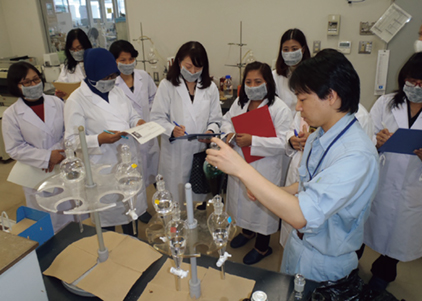ODA Topics 4
The Entry into Force of the “Minamata Convention on Mercury”
With the unique property of being a liquid state metal at normal temperature, mercury can easily be released to the environment from a variety of sources, which persists in the environment and cycles globally without being decomposed. Mercury is also known for its toxicity, in particular methylmercury, which biologically accumulates when passing through the food web, adversely affecting the developing nervous system of fetus and infants. The environmental mercury levels have increased due to the anthropogenic emissions of mercury along with the advancement of industrialization. In recent years, mercury emissions in developing countries are recognized as a global concern to be addressed. Given this understanding, the “Minamata Convention on Mercury” (hereinafter referred to as the “Minamata Convention”) was adopted at the “Conference of Plenipotentiaries on the Minamata Convention on Mercury” (hereinafter referred to as “Conference”) held in Kumamoto City and Minamata City in October 2013 to prevent global scale mercury contamination and the damage to human health it causes.
The Minamata Convention is aimed to protect the human health and the environment from the anthropogenic emissions and releases of mercury and mercury compounds, recognizing the substantial lessons of Minamata disease. It calls for comprehensive measures to be taken at the entire lifecycle of mercury, from extraction to trade, manufacturing, use, emission to the environment, and disposal. It is a remarkable achievement that many countries throughout the world have agreed to minimize the adverse effects of mercury under this convention.
The Minamata Convention was to enter into force on the 90th day after the date of deposit of the 50th instrument of ratification, and the Minamata Convention fulfilled the requirement and entered into force on August 16, 2017 (84 states and the European Union have concluded the process as of the end of 2017). The first meeting of the Conference of Parties (COP 1) was held in Geneva, Switzerland in September of the same year to decide matters necessary for managing the Minamata Convention including the secretariat structure, work plan, and budget, as well as technical matters regarding mercury control. The Mayor and residents of Minamata City attended the COP1 to promote information dissemination, including speeches given at a special event entitled “A Moment to Minamata.” The participation of the residents of Minamata City in COP1 was extremely meaningful in the sense that they were able to convey to the world the lessons and experience of Minamata disease and express their hope that the health damage and environmental disruption like Minamata disease should never be repeated.

The training of mercury monitoring technology for technical experts from South East Asia (Photo: Ministry of the Environment)
At the Conference, then Minister of the Environment Ishihara announced a program to promote voices and messages from Minamata and to support developing countries through the actions titled “MOYAI Initiative.”* In Minamata City, there are various knowledge and human resources, and by utilizing these assets, the dissemination of information on awareness and understanding for the Minamata Convention has been promoted as a contribution rooted in Minamata. Moreover, support for developing countries is being further strengthened and advanced under the MOYAI Initiative for Networking, Assessment and Strengthening (MINAS) program. Specific initiatives moving forward are (i) Establishing a mercury monitoring network in the Asia-Pacific region, (ii) Supporting developing countries for the survey and assessment of their use and emissions of mercury, (iii) Surveying development needs on mercury management in developing countries and the international deployment of Japanese mercury management technologies. Meanwhile, at the Conference, Prime Minister Abe and then Minister of Foreign Affairs Kishida announced that Japan would implement $2 billion of ODA for measures against environmental contamination in developing countries while working through JICA to provide assistance for the training of personnel specialized in mercury pollution management in three years beginning in 2014. These programs have been steadily carried out.
Japan possesses advanced technologies for mercury management and reduction or advanced systems for mercury recycling. Among these, mercury monitoring is one of the areas where technical cooperation from Japan is particularly expected. At the environmental policy dialogue between the U.S. Environmental Protection Agency and the Ministry of the Environment of Japan, they confirmed that they would jointly support the mercury monitoring network in the Asia-Pacific region. The two countries have undertaken regional technical trainings and expert meetings with close coordination with the United Nations Environment Programme and World Health Organization. Japan will promote regional cooperation in the area of obtaining reliable mercury monitoring data that can be used to evaluate the effectiveness of the implementation of the Minamata Convention.
There continues to exist international concern on environmental pollution and health impacts caused by mercury. It is expected that the international framework established by the Minamata Convention, which already entered into force, will function effectively to make progress in global mercury management.
* The word “moyai” originally means the mooring ropes used to tie boats together, or the act of working together in rural farming villages. In Minamata, the initiatives to rebuild the community destroyed by Minamata disease by engaging in dialogue and cooperation are called “moyai-naoshi” (repairing moyai).
